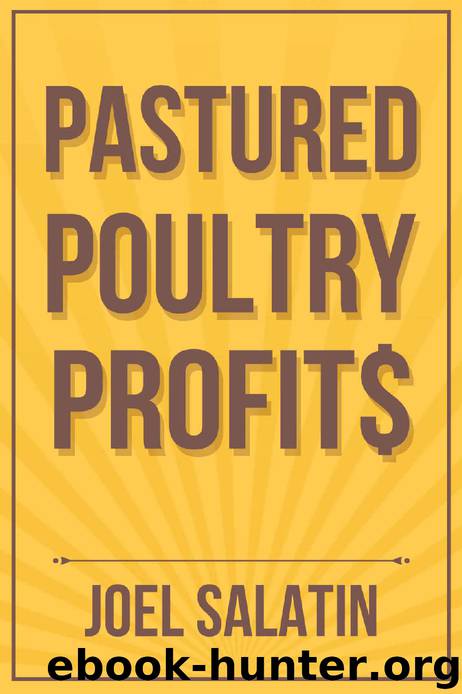Pastured Poultry Profit$ by Joel Salatin

Author:Joel Salatin [Salatin, Joel]
Language: eng
Format: epub
Published: 2018-03-07T06:00:00+00:00
Chapter 26
Solving Your Own Problems
A pioneer is on his own. Forging beyond traditional boundaries, whether they be academic, philosophical or practical, carries with it inherent risks. The greatest risk is that we must solve our problems ourselves, with neither the encouragement nor the knowledge of others who have gone that way before. So it was in our fifth year of raising broilers unconventionally that we had to overcome a terrible problem. What follows is a recap of our observations, our thinking and our experiences.
Our goal in recapping this event is to encourage other pioneers to conquer their unique problems. And to illustrate that conventional thinking does not apply to pioneers:it just can’t adapt.
In August we received a batch of a thousand day old Cornish Cross chicks. The summer had been successful thus far, with little mortality and good carcass weights. These chicks, smaller than normal, were hatched from pullet eggs. The breeder flock was just coming into production, and their small eggs made small chicks. We were assured that the genetics were fine, but they needed some extra care.
They started off fine and on about the ninth day I moved them out of the brooder house into our portable, floorless cages on pasture. Two days later, several birds showed lameness. The hyped up breeding in the meat chicken industry has brought with it leg problems, a major plague in the industry. Subtherapeutic antibiotic administration reduces joint swelling and reduces the crippling.
Since we do not use antibiotics, we fight lameness by adding alfalfa meal to the ration for organic vitamin A (aids in metabolizing of calcium), being fanatically meticulous about moisture in the brooder house (keeping the floor dry) , splitting the soybean meal component of the ration in half so the other half is roasted soybeans (keeps the vitamin rich oils), and adding probiotic (Lactobacillus acidophilus) to the ration.
Just when we put this batch of birds out in the field, the weather turned cool and damp. Immediately I attributed the lameness to that. Over the years we had come to believe that in small birds lameness was incurable. We disposed of those birds quickly to reduce their suffering.
The next day, which was day 13, more chicks became lame. It peaked at about day 20 and tapered off until day 28, when we found no more cripples. At that point, we had lost about 30 percent.
Another batch of chicks came, similar to the earlier one, and they started the same thing at day 12. I kept these in the brooder house, however, to make sure they stayed warm and dry. When the same thing began happening to them, I knew it had nothing to do with the weather. At day 14, I took cripples from both groups to the state laboratory for diagnosis. We couldn’t afford another loss of 30 percent.
I sat in the brooder house and watched the lame birds. Their problems seemed to begin with foot paralysis. Their toes would curl under; this would throw them off balance, and then they would rock back on their hocks to move around.
Download
This site does not store any files on its server. We only index and link to content provided by other sites. Please contact the content providers to delete copyright contents if any and email us, we'll remove relevant links or contents immediately.
| Consulting | Entrepreneurship |
| Franchises | Home Based |
| Marketing | New Business Enterprises |
| Nonprofit Organizations & Charities |
Pioneering Portfolio Management by David F. Swensen(6226)
Man-made Catastrophes and Risk Information Concealment by Dmitry Chernov & Didier Sornette(5921)
Zero to One by Peter Thiel(5684)
The Motivation Myth by Jeff Haden(5155)
The Miracle Morning by Hal Elrod(4637)
Elon Musk by Ashlee Vance(4023)
The Art of Persistence: Stop Quitting, Ignore Shiny Objects and Climb Your Way to Success by Michal Stawicki(3623)
Unlabel: Selling You Without Selling Out by Marc Ecko(3587)
Delivering Happiness by Tony Hsieh(3363)
Urban Outlaw by Magnus Walker(3338)
Purple Cow by Seth Godin(3137)
Mastering Bitcoin: Programming the Open Blockchain by Andreas M. Antonopoulos(2980)
The Marketing Plan Handbook: Develop Big-Picture Marketing Plans for Pennies on the Dollar by Robert W. Bly(2975)
The Power of Broke by Daymond John(2895)
The Content Trap by Bharat Anand(2860)
Applied Empathy by Michael Ventura(2838)
The Airbnb Story by Leigh Gallagher(2797)
Keep Going by Austin Kleon(2696)
Radical Candor by Kim Scott(2667)
